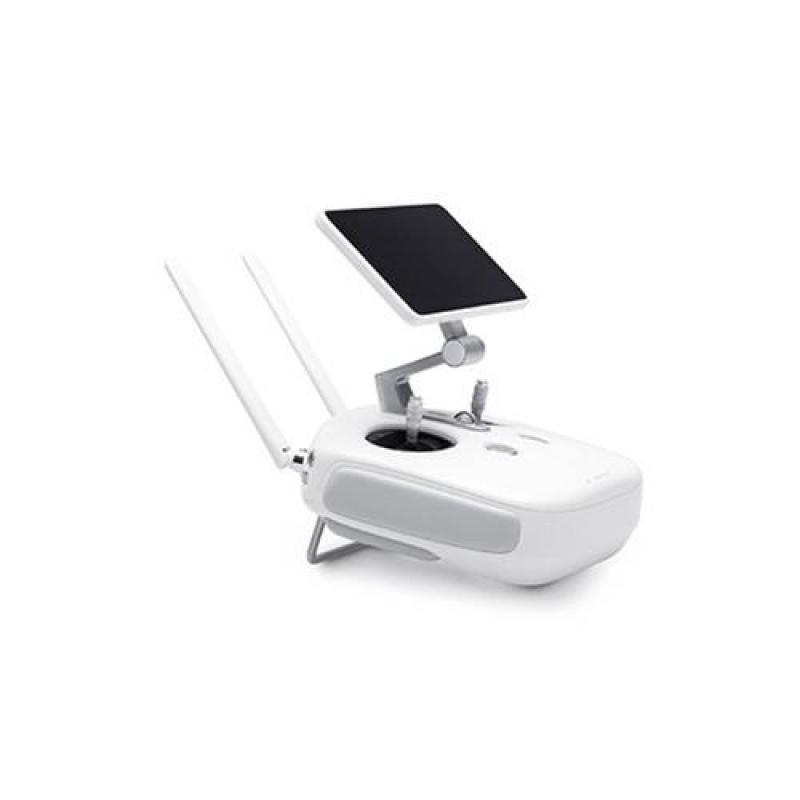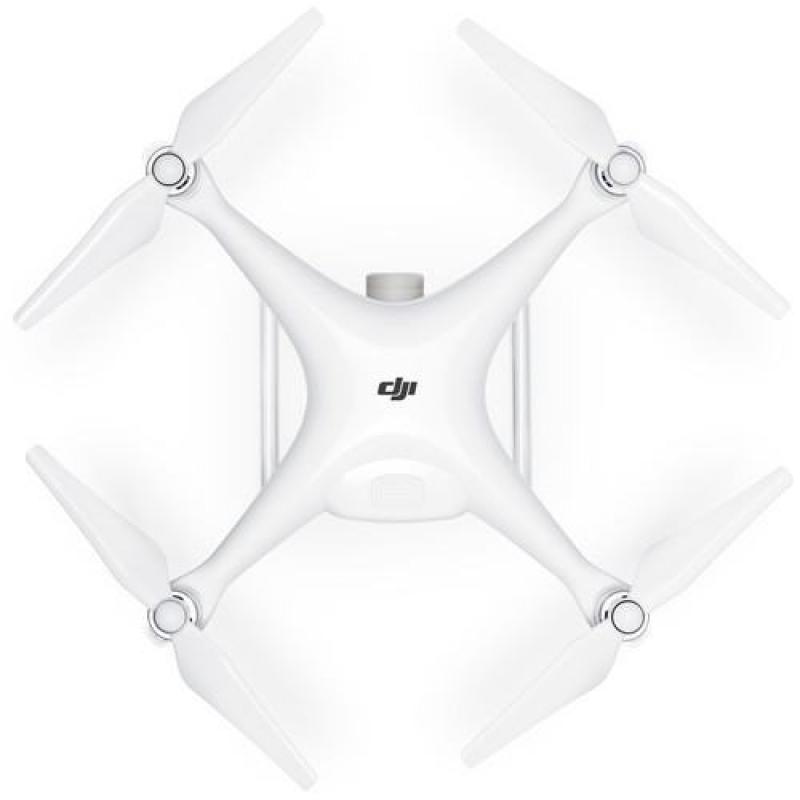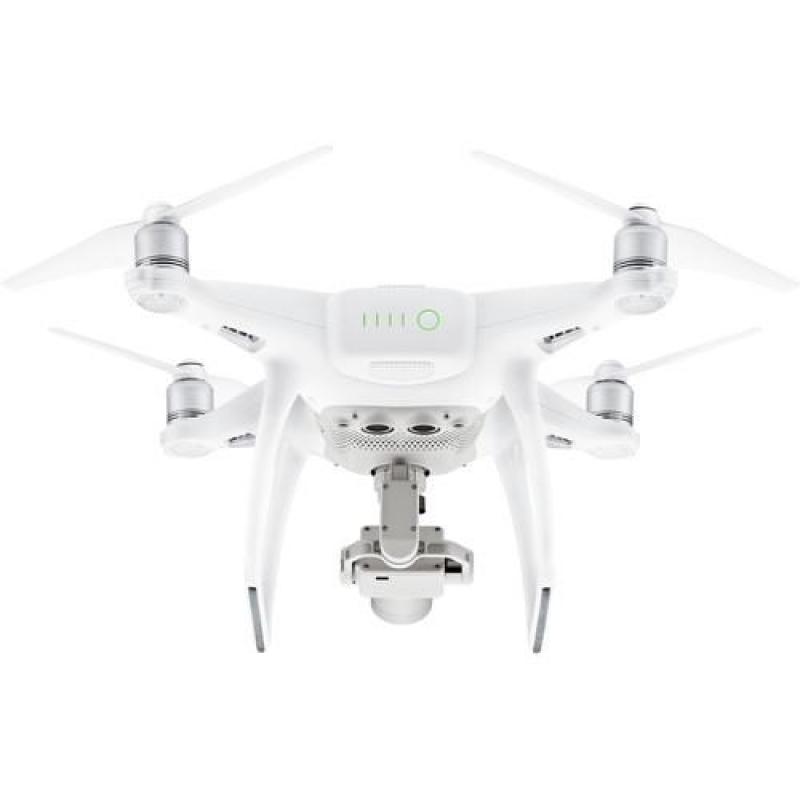DESCRIPTION:
The Phantom 4 Advanced+ from DJI boasts a 3-axis-stabilized gimbal camera with a 20MP, 1" CMOS sensor capable of shooting up to 4K/60fps video as well as photo bursts at up to 14 fps. Distinct from its sibling, the Phantom 4 Pro+, this Phantom benefits from a total of five vision sensors, which enable precise navigation where GPS is unavailable and provide two directions of obstacle detection. Additionally, it adopts a titanium and magnesium body for increased rigidity and reduced weight. Like the Pro+, the Advanced+ can attain a top speed of 45 mph in Sport Mode and can fly for up to 30 minutes.
This variant features an integrated Android device with 5.5" 1080p display for live view and operating app-based functions.
Gimbal Camera with 1" CMOS Sensor
The onboard camera features a 1-inch 20-megapixel CMOS sensor. A custom-engineered lens made up of eight elements is arranged in seven groups. The camera boasts a mechanical aperture that eliminates rolling shutter distortion that can occur when taking images of fast moving subjects or when flying at high speed and a mechanical focus.
1" CMOS Sensor
Sensor size is often more important to image quality than the number of pixels, because a larger sensor has dynamic range, better signal-to-noise ratio, and boosted low light performance. The 1" 20MP CMOS sensor in the Phantom 4 Advanced+ is almost four times the size of the Phantom 4's 1/2.3" sensor. It uses larger pixels and has a maximum ISO of up to 12,800 as well as increased contrast.
H.264 and H.265 4K Video Recording
Powerful video processing supports H.264 4K videos at 60 fps or H.265 4K at 30 fps, both recorded in a 100 Mbps bit rate. Advanced+ sensors and processors ensure everything is captured with more image detail and the image data needed for manipulation in post-production.
Production-Optimized 4K
An enhanced video processing system allows video to be captured in cinema- and production- optimized DCI 4K (4096 x 2160) at 60 fps and a bit rate of 100 Mbps. The Phantom 4 Advanced+ also supports the H.265 video codec at 30 fps in 4K resolution. For a given bit rate, H.265 doubles the amount of image processing as H.264, resulting in significantly enhanced image quality from a more efficient compression. Record in the high dynamic range D-log mode to make the most of this image data for color grading.
High Resolution Lens
The Phantom 4 Advanced+ camera has an aerial-optimized f/2.8 wide-angle lens with a 24mm-equivalent focal length. It features eight elements — two aspherical — arranged in seven groups that fit into a smaller, more compact frame. Its images are consistently detailed with low distortion and low dispersion, ensuring that photos and videos are sharp and vivid.
Mechanical Shutter
Capturing objects moving at high speed has always been a challenge for flying cameras using an electronic shutter. This is why the Phantom 4 Advanced+ uses a mechanical shutter and a large-aperture prime lens. A maximum mechanical shutter speed of 1/2000-second eliminates motion blur and "jello effect" caused by shooting a fast-moving object with a rolling electronic shutter. The electronic shutter has also boasts a max speed of 1/8000-second, and a there is a Burst Mode capable of shooting 14 fps at 20 megapixels to catch the perfect moment.
Five Vision Sensors
Equipped with the FlightAutonomy system made up of five vision sensors, dual-band satellite positioning (GPS and GLONASS), ultrasonic rangefinders and redundant sensors, the Phantom 4 Advanced+ is able to hover precisely in places without GPS and fly in complex environments. The dual forward vision sensors can see as far as 98' out in front, and enable auto brake, hover, or detour in front of obstacles within a 49-foot range.
Remote Controller with Lightbridge HD Video Link
The Phantom 4 Remote Controller with 1080p Display integrates an upgraded Lightbridge HD video transmission which enables up to 720p HD live view with a range of up to 4.3 miles. The system uses a combined 2.4 GHz signal for both control and monitoring. This in contrast to the Phantom 4 Pro, which also offers a 5.8 GHz channel for Lightbridge. The built-in DJI GO 4 app can allow you to live stream, edit and share your aerial videos and photos instantly.
Integrated 1080p Display
A 5.5" 1080p screen integrated w offers 1000 cd/m² of brightness, more than twice as bright as conventional smart devices. It makes bright, vivid colors easily visible in direct sunlight. With this screen, a mobile device is not required, simplifying pre-flight preparations. As the DJI GO app is built into the screen, hardware and software can be fully optimized, further reducing video lag. Integration of an HDMI port, microSD card slot, microphone, embedded loudspeaker, and Wi-Fi connection allow images to be edited inside DJI GO to be shared almost instantly. Lastly, a five-hour battery life makes the Phantom 4 Advanced${variant-name} a complete aerial imaging solution.
Intelligent Flight Modes
Draw
With Draw, simply draw a route on screen and the Phantom 4 Advanced+ will move in that direction while keeping its altitude locked. This allows the pilot to focus on camera control and enables more complex shots. There are two Draw modes that can be used in different scenarios:
Standard: The aircraft follows the route at a constant speed with the camera facing in the direction of flight.
Free: The aircraft only moves along the route when instructed. In this mode, the camera can face in any direction during a flight.
ActiveTrack
Following fast-moving objects can be very challenging, but Advanced+, image-recognition algorithms used by the Phantom 4 Advanced+ allow it to recognize and track an object while keeping it in frame. This algorithm also recognizes a range of subjects, from people to vehicles to animals, and will adjust its flight dynamics to match, ensuring smoother shots. Pilots can now choose between:
Trace: Follow behind or in front of a subject, avoiding obstacles automatically.
Profile: Fly alongside a subject at a variety of angles to get profile shots of the subject.
Spotlight: Keep the camera trained on a subject while the aircraft flies almost anywhere.
TapFly
Fly in any direction visible on-screen with a simple tap. Tap anywhere on-screen to smoothly adjust the direction of flight while automatically avoiding obstacles and tap the screen again or use control sticks to change direction. An AR route function shows the aircraft's real-time flight direction for reference as its route is adjusted. As it can be difficult to control altitude, course, speed and camera pitch simultaneously using joysticks, TapFly Free allows a pilot to set the direction of flight, allowing them to turn the Phantom 4 Advanced+ or tilt the gimbal as required without changing the direction of flight. There are two TapFly modes:
TapFly Forward: Tap to fly in the selected direction
TapFly Free: Lock the forward direction of the Phantom without locking the camera direction allowing it to turn as it flies.
Note: Obstacle Avoidance is not available with TapFly Free.
Return to Home
In its Return to Home mode, the Phantom 4 Advanced+ can automatically choose the best route to return home depending on environmental conditions. It records its route as it flies, allowing it to return along the same route avoiding obstacles if the control signal is disconnected.
Based on its altitude at the time of disconnection, the Phantom 4 Advanced+ is also able to adjust its flight path to avoid obstacles it has seen during its flight. At takeoff, the drone will record the scene below and compare its recording with what it sees as it returns, for more precise landing. It can also detect the ground to see whether there is suitable spot for landing. If any obstacles are found, or there is water on the ground, it will alert the pilot and hover at an appropriate height, helping the aircraft to land more safely.
Gesture Mode
With Gesture Mode, selfies can be captured using a few gestures without the remote controller. Computer vision technology allows the Phantom 4 Advanced+ to take instructions through gestures. The subject simply lifts their arms when facing the camera and the aircraft will recognize this movement by locking on and placing the subject in the center of the frame. When ready for a photo, the subject holds their arms out to signal the aircraft. A three-second countdown will begin, making time to strike a pose, allowing moments to be captured without the remote control.
Flight Control System
Flight Modes
Different productions require different flight characteristics, and the Advanced+ offers three modes for flight: P, A and S. Switching between them allows pilots to get the control they need, whether they seek smoothness, simplicity, intelligent navigation, or speed. In Position Mode (P), TapFly, ActiveTrack, obstacle sensing and positioning features are available. Sport Mode (S) adds extra agility and higher speed, reaching 45 mph. Attitude Mode (A) switches off satellite stabilization and holds the Phantom 4 Advanced+'s altitude. It is ideal for experienced pilots looking to capture smoother footage. Tripod Mode, which limits speed to 4 mph provides precision control for fine framing and indoor flying. Both the infrared sensing system and vision sensors are enabled in these modes for a safer flight experience.
Sensor Redundancy
The Phantom 4 Advanced+ features dual compass modules and dual IMU units, making it more reliable when compared to many hexacopters and octocopers. Compasses and IMUs are important sensors to ensure a stable flight, and the Phantom 4 Advanced+ constantly compares the data it receives through both pairs. This data is run through various algorithms to check accuracy, and any inaccurate data is simply discarded without affecting flight, keeping flight steady and reliable.
Intelligent Battery System
Professional aerial imaging benefits from longer flight times. The Phantom 4 Advanced+ features a maximum flight time of 30 minutes, providing more time in the air to capture the perfect shot. The DJI GO app shows battery lifetime and calculates remaining flight times according to distance traveled and more. It will give alerts when it reaches a minimum safe amount required for a safe journey back to the takeoff point. An Advanced+ battery management system is also in place to prevent overcharging and over-draining. When placed in longer term storage, batteries will discharge power to maintain good health.




